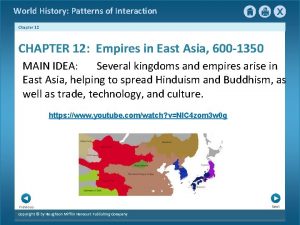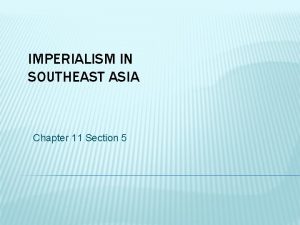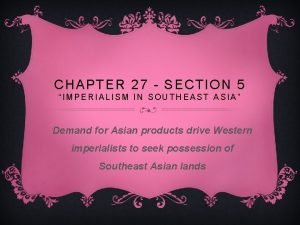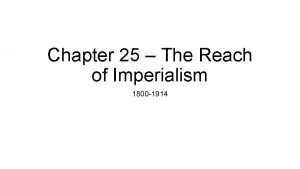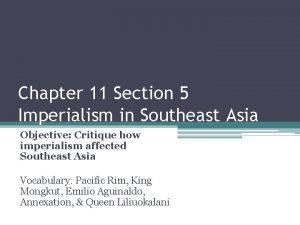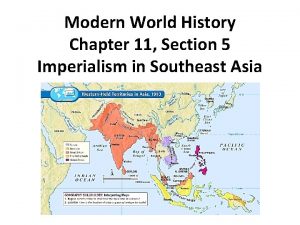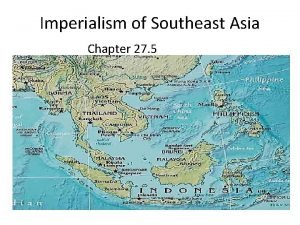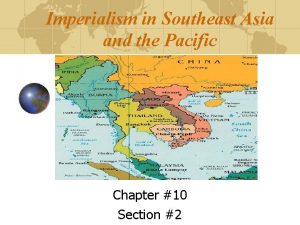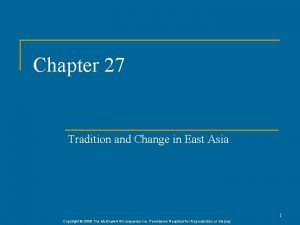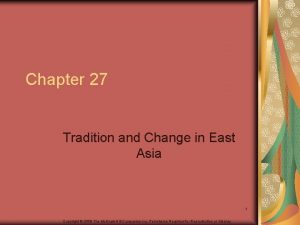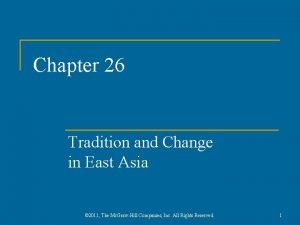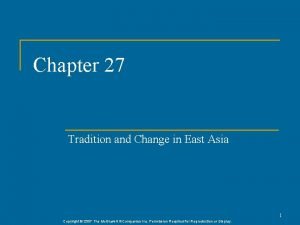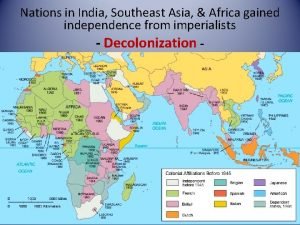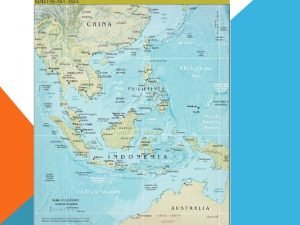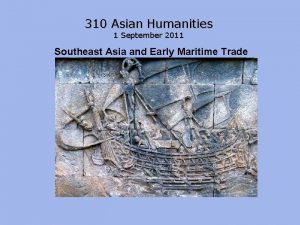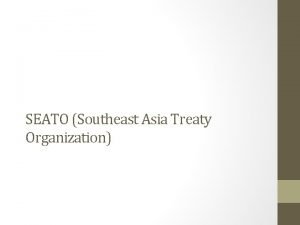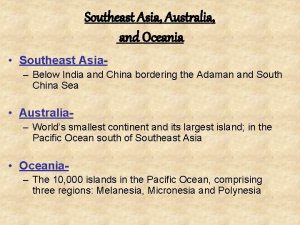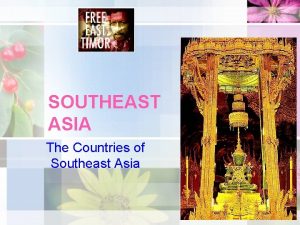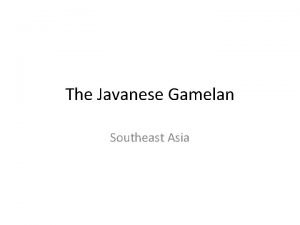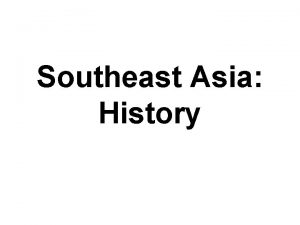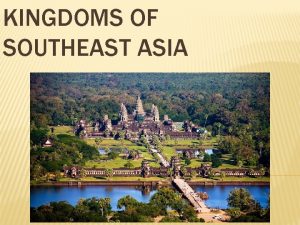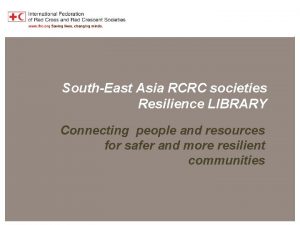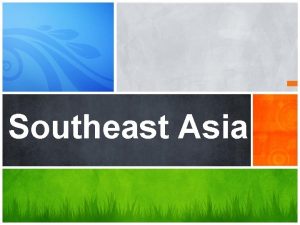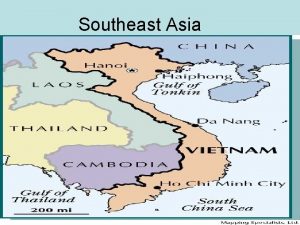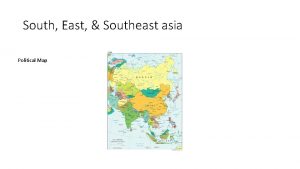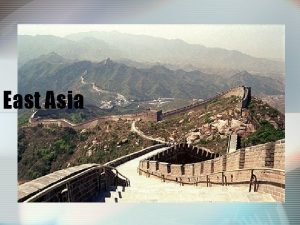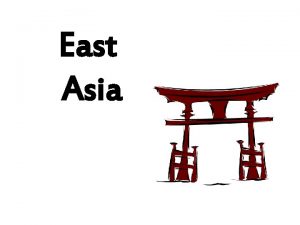Chapter 34 Southeast and East Asia in the



















- Slides: 19

Chapter 34 Southeast and East Asia in the 20 th century “The Chinese People's Liberation Army is the great school of Mao Zedong Thought”

New Divisions and the End of Empires • Following WWII, Asia was reorganized by Allies. • Korea divided into USSR (N) and US (S) zone • S: Republic of Korea • N: People’s Democratic Republic of Korea • Taiwan under Kuomintang control (led by Chiang Kai-Shek) • Japan occupied by United States • Postwar decolonization: Philippines (U. S. ), Indonesia (Dutch), Malaysia (British) • France hangs on to Indochina Pacific Rim by 1960

• South Korean War (1950 -1953): North invades South, 1950 • U. S. supports S; China supports N • Indecisive conclusion: most territory same as prewar status • North: communist; governed by Kim Il-Sung until 1994 • South: parliamentary government • Early period of government characterized by corruption, and strict military leadership. • 1980 s: General elections, greater freedom of the press was slowly established. • Industrialization was heavily supported from the mid-1950 s on (steel, automobiles); followed the Japanese model. • Growing population pressures led to statesupported birth control.

Taiwan (Republic of China) • Conquered by Qing Dynasty • Japanese control in WWII; give back to Kuomintang China • 1950: After Chinese Civil War ends, Kuomintang retreated to Taiwan and occupy it with US support, while Mao and Communists controlled mainland China. • Mao and PRC claim island as part of mainland China • Taiwan claims it is Republic of China and has jurisdiction over mainland China • Aid from the US supported the Taiwanese into the 1960 s. • US recognizes Taiwanese independence • 1978: Death of Chiang Kai-shek • 1978 -1988: Replaced by son Chiang Ching-kuo. • Rapid economic growth. • Involved in global textile trade • Improved education and cultural change.

Hong Kong and Singapore • Hong Kong • Remained a British colony until 1997 • 1997: Returns to People’s Republic of China • Involved in global textile trade • Singapore • Under British rule until 1965, when it achieved independence. • Used as a naval port • Involved in textiles, electronics, oil • Largest city-state in the world • 1959 -1990: Prime Minister Lee Kuan Yew held tight power over its citizens. • Shipping; manufacturing; banking. • By about 1960, many of the smaller east Asian nations had achieved stability.

Japanese Recovery • In spite of extensive destruction during the war, Japan was able to recover quickly. • 1952: American occupation ends, but Japan is heavily reorganized by the U. S. • Americans pressed for democratization: • Women’s suffrage • Encouraged unions • Abolished Shintoism as state religion. • New constitution: guaranteed civil liberties, limited military strength, made emperor symbolic; social security program for elderly • 1955 -1993: Liberal Democratic Party monopolized Japanese government. • Economic development based on cooperation between public and private sectors • State supports birth control and abortion; state intervention has controlled population growth. • Corruption raises questions • Currently, Japan is a constitutional monarchy dominated by a political and economic oligarchy Douglas Mac. Arthur and Emperor Hirohito

Japanese Culture • Japanese cultural traditions have been preserved. • Kabuki (traditional Japanese theater with elaborate makeup and drama); poetry; tea ceremonies • Western influence shown by popularity of baseball, tennis, golf, American movies, art, music, and clothing. • Japanese women enjoyed more education, but spend more time on domestic duties due to traditional attitudes. • Feminism occurs, but is not nationwide as in US; confined to intellectuals

Japanese Economic Surge • Japan’s economy grew remarkably, especially after 1950 s. • Unions encouraged • Government played a large role in economic development • Spending little on the military, the government could afford to spend elsewhere • Encouraged high economic performance, especially in cars and electronics. • Cut into US and European markets • Current political issues: pollution and political corruption in rapidly expanding cities.

Quick Review Question 1. Describe the history of Taiwan after WWII. 2. How does the United States affect Japan in the post-WWII era?

End of Chinese Civil War (1927 -1950) • In the Chinese Civil War, the Communists defeat the Nationalists. • Chiang Kai-Shek and Nationalists escape to Taiwan • Mao declared the People’s Republic of China. • Mao won support in China by defeating the Japanese, but also by land reform and by giving the peasants a central role in the government. • Worked to assert China’s traditional preeminence in East and Southeast Asia through the People’s Liberation Army. • Potential secession movements were repressed in inner Mongolia, Tibet. • Remodel China using a Soviet model • Cooperation between China and the Soviet Union diminished after the death of Stalin in the late 1950 s. • Mao now saw himself as the leader amongst Communists.

Mass Line Approach (1955) and the Hundred Flowers Campaign (1957) • Industrialization: Mao’s key goal. • 1952: Land redistribution was led by purging the landowning class, with as many as 3 million executed. • 1953: First five-year plan • Mass Line approach (1955): collectivized farms, which reversed the distribution of land that had been achieved in 1952. • Hundred Flowers Campaign (1957): Mao encouraged intellectuals to speak out about Communist rule; they were critical, and were punished harshly. • Limiting family size (begins in 1960 s) • Rural families ≤ 1; Urban families ≤ 2 • By 1980 s, only one child per family allowed • By 2007, couples who are both only children can have two children • Result is abortions; sterilizations; female infanticide

The Great Leap Forward (1958 -1960) • The Great Leap Forward (1958 -1960): attempted to bring about industrialization at the local, rural level, supervised by peasant communes. • Balance industry with traditional Chinese agriculture • Peasants were un-cooperative and resistant, in addition to corruption by officials • Too much labor diverted to GLF led to massive famine. • Complete failure; dismal output • Mao was no longer Chairman, but still head of Communist party • Replaced by Pragmatists (Zhou Enlai and Deng Xiaoping) • Opposed the Great Leap Forward and tried to stimulate the Chinese economy through market incentives, private enterprises, stock exchange

The Cultural Revolution (1965 -1968) and Fall of the Gang of Four • Cultural Revolution (1965 -1968): Mao’s opposition to the new pragmatist administration • Mao’s Red Guard forces attacked Mao’s rivals, who were killed, executed or exiled, as well as attacking educated and the elite. • Destroyed much of China’s traditional culture in favor of a “new world” • The movement achieved the overthrow of the government Mao had hoped for, but then continued, out of control until 1971. • 1972: The Gang of Four plotted to overthrow the pragmatists and reinstate Mao, but were not successful. • Jiang Qing and 3 Communist party leaders • 1976: Both Mao Zedong and Zhou Enlai died; Deng Xiaoping became leader. • Xiaoping interested in Western reforms; gets rid of collective farming • No democratic reforms Tiananmen Square (1989), a pro-democracy movement by students "Destroy the old world; Forge the new world. " A Red Guard crushes the crucifix, Buddha, and classical Chinese texts with his hammer

Two Expectations for Women • Madam Chiang Kai-shek stressed traditional women’s roles • Result: greater support for Communists rather than for Nationalists. • Retreats to Taiwan with her husband • Jiang Qing (Mao’s wife) promoted legal equality for women. • Women rose in the military and could bear arms • More women worked outside the home as opportunities increased. • High positions were still usually held by men.

Quick Review Question 1. What constitutes Mao’s Great Leap Forward? 2. What is the goal of the Cultural Revolution? What is targeted?

Ho Chi Minh and Vietnamese Marxism • Under French colonial rule, the emperor, bureaucracy, and Confucianism are discredited. • French attempt to maximize profits: exacerbated overcrowding and migration of peasants to urban areas. • 1920 s: Rising nationalism centered around the Vietnamese Nationalist Party • A failed 1929 revolt weakened the party. • The Communist Party of Vietnam was left to rally resistance to the French. • Ho Chi Minh led the party and adapted Marxism to work for the peasant majority in Vietnam. • Mixed nationalism with communism • After Japanese invasion of Vietnam in WWII, France wanted to regain its colony but was vulnerable to rebellion. • 1945: Ho Chi Minh declares an independent Vietnam.

Vietnam War (1956 -1975) • First French Indochina War (1946 -1954) • Viet Minh (communist-dominated nationalist party) used guerilla fighting against the French and Japanese to gain control of northern Vietnam. • 1946: French try to stabilize southern Vietnam. • 1954: French were defeated at Dien Bien Phu; withdraw. • 1954: Geneva Conference determined Vietnam will be divided into Viet Minh-controlled north and French south. • 1955: In accordance with “containment, ” US installed Ngo Dinh Diem as president of South Vietnam. • Vietnam War (Second French Indochina War; 1956 -1975) • 1956: Communists in the south (Viet Cong) vs. Diem and Americans increased communist support Viet Minh. • US sent increasing support, including nearly 500, 000 troops in 1968, but was finally forced to retreat in the 1970 s. • 1975: government in south fell; Communists rule north and south

Continued Struggle in Vietnam • Vietnam is one of the leading exporters of rice (essentially single-export; leaves little for families) • Vietnam remains isolated from international aid, in part because of US international pressure. • Attempts put in place to impose hard-line Marxism failed to ease poverty. • From the 1980 s, Vietnam has been more open to liberalizing and to outside investors, boosting economic growth. • Harsh conditions for workers: sweatshop conditions.

Quick Review Question 1. What is the outcome of the First Indochina War? 2. How does the United States become involved in the Vietnam War? 3. Describe Vietnam today.
 Chapter 12 section 5 kingdoms of southeast asia and korea
Chapter 12 section 5 kingdoms of southeast asia and korea Imperialism in southeast asia chapter 11 section 5
Imperialism in southeast asia chapter 11 section 5 Imperialism in southeast asia chapter 27 section 5
Imperialism in southeast asia chapter 27 section 5 Chapter 25 lesson 4 imperialism in latin america
Chapter 25 lesson 4 imperialism in latin america Chapter 11 section 5 imperialism in southeast asia
Chapter 11 section 5 imperialism in southeast asia Chapter 11 section 5 imperialism in southeast asia
Chapter 11 section 5 imperialism in southeast asia Chapter 27 section 5 imperialism in southeast asia
Chapter 27 section 5 imperialism in southeast asia Mainland of southeast asia
Mainland of southeast asia Imperialism in southeast asia and the pacific
Imperialism in southeast asia and the pacific Chapter 27 tradition and change in east asia
Chapter 27 tradition and change in east asia Chapter 27 tradition and change in east asia
Chapter 27 tradition and change in east asia Chapter 26 tradition and change in east asia
Chapter 26 tradition and change in east asia Chapter 27 tradition and change in east asia
Chapter 27 tradition and change in east asia African city model
African city model Landforms of southeast asia
Landforms of southeast asia Is india southeast asia
Is india southeast asia Mon khmer
Mon khmer Lesson 1 physical geography of southeast asia
Lesson 1 physical geography of southeast asia Southeast asian alphabets
Southeast asian alphabets Countries in southeast asia
Countries in southeast asia
